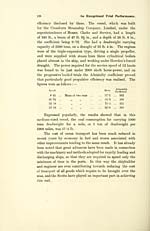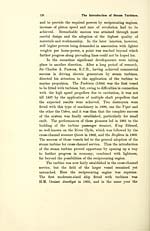Two centuries of shipbuilding by the Scotts at Greenock
(249) [Page 127] - Marine engineering progress
Download files
Complete book:
Individual page:
Thumbnail gallery: Grid view | List view
![(249) [Page 127] - Marine engineering progress](https://deriv.nls.uk/dcn17/9574/95741653.17.jpg)
Marine Engineering Progress.
* *
AKING the period up to the declaration
of war, the quadruple-expansion engine
had to a considerable extent superseded
the triple-expansion engine for ships
intended to make long voyages, and
more especially for passenger liners in
which a four-crank engine had to be
fitted on account of the higher powers and greater smoothness
of running demanded. For cargo steamers, even of large
size, the majority of owners still preferred the three-cylinder
engine, as it was considered that any gain in fuel economy,
due to the quadruple principle, was neutralised by the loss
in cargo space, because of the greater length needed for the
latter engine, and its increased first cost, weight and expense in
maintenance.
Turning to the faster vessels associated with the
passenger service, the reciprocating engine appears in a new light.
It was in the cross-channel passenger service that the inherent
limitations of the reciprocating engines became first apparent.
In these vessels, it is, on the one hand, of the highest
importance to reduce weight wherever possible, so as to
minimise tonnage, and save harbour dues ; while, on the other
hand, it is necessary to obtain very high speeds to suit the
public convenience, and this on a ship restricted in size by
available harbour accommodation. To meet these conditions,
* *
AKING the period up to the declaration
of war, the quadruple-expansion engine
had to a considerable extent superseded
the triple-expansion engine for ships
intended to make long voyages, and
more especially for passenger liners in
which a four-crank engine had to be
fitted on account of the higher powers and greater smoothness
of running demanded. For cargo steamers, even of large
size, the majority of owners still preferred the three-cylinder
engine, as it was considered that any gain in fuel economy,
due to the quadruple principle, was neutralised by the loss
in cargo space, because of the greater length needed for the
latter engine, and its increased first cost, weight and expense in
maintenance.
Turning to the faster vessels associated with the
passenger service, the reciprocating engine appears in a new light.
It was in the cross-channel passenger service that the inherent
limitations of the reciprocating engines became first apparent.
In these vessels, it is, on the one hand, of the highest
importance to reduce weight wherever possible, so as to
minimise tonnage, and save harbour dues ; while, on the other
hand, it is necessary to obtain very high speeds to suit the
public convenience, and this on a ship restricted in size by
available harbour accommodation. To meet these conditions,
Set display mode to:
![]() Universal Viewer |
Universal Viewer | ![]() Mirador |
Large image | Transcription
Mirador |
Large image | Transcription
Images and transcriptions on this page, including medium image downloads, may be used under the Creative Commons Attribution 4.0 International Licence unless otherwise stated. ![]()
| Histories of Scottish families > Two centuries of shipbuilding by the Scotts at Greenock > (249) [Page 127] - Marine engineering progress |
|---|
| Permanent URL | https://digital.nls.uk/95741651 |
|---|
| Description | A selection of almost 400 printed items relating to the history of Scottish families, mostly dating from the 19th and early 20th centuries. Includes memoirs, genealogies and clan histories, with a few produced by emigrant families. The earliest family history goes back to AD 916. |
|---|

